The AMD Threadripper 2990WX 32-Core and 2950X 16-Core Review
by Dr. Ian Cutress on August 13, 2018 9:00 AM ESTHEDT Benchmarks: Office Tests
The Office test suite is designed to focus around more industry standard tests that focus on office workflows, system meetings, some synthetics, but we also bundle compiler performance in with this section. For users that have to evaluate hardware in general, these are usually the benchmarks that most consider.
PCMark 10: Industry Standard System Profiler
Futuremark, now known as UL, has developed benchmarks that have become industry standards for around two decades. The latest complete system test suite is PCMark 10, upgrading over PCMark 8 with updated tests and more OpenCL invested into use cases such as video streaming.
PCMark splits its scores into about 14 different areas, including application startup, web, spreadsheets, photo editing, rendering, video conferencing, and physics. We post all of these numbers in our benchmark database, Bench, however the key metric for the review is the overall score.
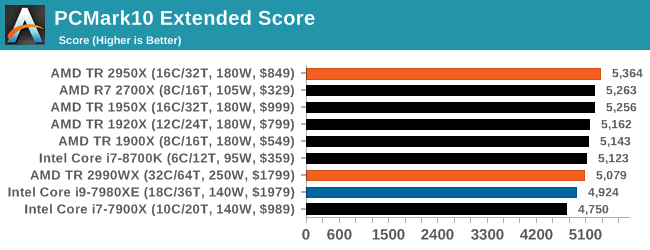
One of the downsides of PCMark is that it seems to bunch up all the results, showing them relatively close together, but interestingly here that the Intel processors sit near the bottom, with the 2950X and 2700X on the podium.
Chromium Compile: Windows VC++ Compile of Chrome 56
A large number of AnandTech readers are software engineers, looking at how the hardware they use performs. While compiling a Linux kernel is ‘standard’ for the reviewers who often compile, our test is a little more varied – we are using the windows instructions to compile Chrome, specifically a Chrome 56 build from March 2017, as that was when we built the test. Google quite handily gives instructions on how to compile with Windows, along with a 400k file download for the repo.
In our test, using Google’s instructions, we use the MSVC compiler and ninja developer tools to manage the compile. As you may expect, the benchmark is variably threaded, with a mix of DRAM requirements that benefit from faster caches. Data procured in our test is the time taken for the compile, which we convert into compiles per day.
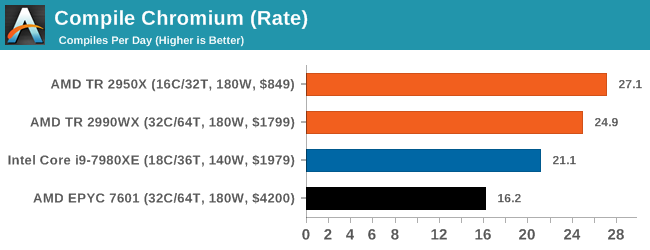
This test is such a nice mix of ST, MT, and memory limited flow that it is really interesting to see where the results end up. Unfortunately for our new suite the output files were not set up correctly, so despite running the test we only ever got a handful of results. But it shows an interesting metric: the 2950X sits ahead of the 2990WX, with both ahead of the Core i9, and the EPYC system being beaten handily due to its lower frequencies.
3DMark Physics: In-Game Physics Compute
Alongside PCMark is 3DMark, Futuremark’s (UL’s) gaming test suite. Each gaming tests consists of one or two GPU heavy scenes, along with a physics test that is indicative of when the test was written and the platform it is aimed at. The main overriding tests, in order of complexity, are Ice Storm, Cloud Gate, Sky Diver, Fire Strike, and Time Spy.
Some of the subtests offer variants, such as Ice Storm Unlimited, which is aimed at mobile platforms with an off-screen rendering, or Fire Strike Ultra which is aimed at high-end 4K systems with lots of the added features turned on. Time Spy also currently has an AVX-512 mode (which we may be using in the future).
For our tests, we report in Bench the results from every physics test, but for the sake of the review we keep it to the most demanding of each scene: Ice Storm Unlimited, Cloud Gate, Sky Diver, Fire Strike Ultra, and Time Spy.

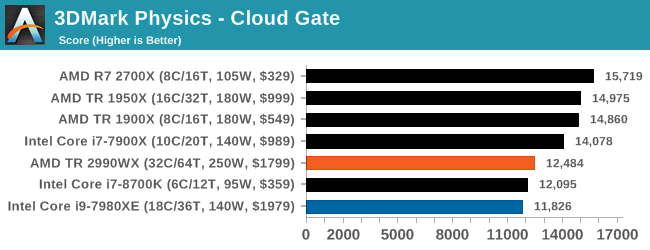

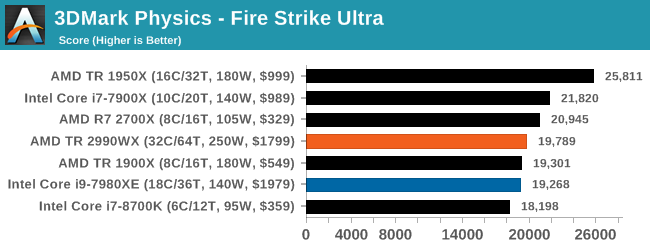
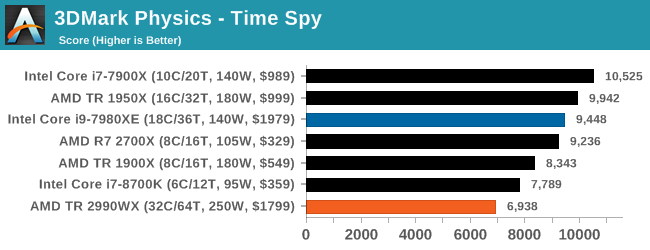
In the low end tests, it is clear that having these big processors doesn’t do much for performance, but even as we go up through Fire Strike and Time Spy, there seems to be a natural limit to the usefulness of these parts. Physics clearly loves having some extra memory bandwidth, and we know Time Spy isn’t meant to scale beyond about 10 cores, but we do see the 10 core processor sitting out front. Some of our testing sweeps had this benchmark configured incorrectly so it will be interesting to see how it fills out with some other mid and high core count processors.
GeekBench4: Synthetics
A common tool for cross-platform testing between mobile, PC, and Mac, GeekBench 4 is an ultimate exercise in synthetic testing across a range of algorithms looking for peak throughput. Tests include encryption, compression, fast fourier transform, memory operations, n-body physics, matrix operations, histogram manipulation, and HTML parsing.
I’m including this test due to popular demand, although the results do come across as overly synthetic, and a lot of users often put a lot of weight behind the test due to the fact that it is compiled across different platforms (although with different compilers).
We record the main subtest scores (Crypto, Integer, Floating Point, Memory) in our benchmark database, but for the review we post the overall single and multi-threaded results.












171 Comments
View All Comments
plonk420 - Tuesday, August 14, 2018 - link
worse for efficiency?https://techreport.com/r.x/2018_08_13_AMD_s_Ryzen_...
Railgun - Monday, August 13, 2018 - link
How can you tell? The article isn’t even finished.mapesdhs - Monday, August 13, 2018 - link
People will argue a lot here about performance per watt and suchlike, but in the real world the cost of the software and the annual license renewal is often far more than the base hw cost, resulting in a long term TCO that dwarfs any differences in some CPU cost. I'm referring here to the kind of user that would find the 32c option relevant.Also missing from the article is the notion of being able to run multiple medium scale tasks on the same system, eg. 3 or 4 tasks each of which is using 8 to 10 cores. This is quite common practice. An article can only test so much though, at this level of hw the number of different parameters to consider can be very large.
Most people on tech forums of this kind will default to tasks like 3D rendering and video conversion when thinking about compute loads that can use a lot of cores, but those are very different to QCD, FEA and dozens of other tasks in research and data crunching. Some will match the arch AMD is using, others won't; some could be tweaked to run better, others will be fine with 6 to 10 cores and just run 4 instances testing different things. It varies.
Talking to an admin at COSMOS years ago, I was told that even coders with seemingly unlimited cores to play with found it quite hard to scale relevant code beyond about 512 cores, so instead for the sort of work they were doing, the centre would run multilple simulations at the same time, which on the hw platform in question worked very nicely indeed (1856 cores of the SandyBridge-EP era, 14.5TB of globally shared memory, used primarily for research in cosmology, astrophysics and particle physics; squish it all into a laptop and I'm sure Sheldon would be happy. :D) That was back in 2012, but the same concepts apply today.
For TR2, the tricky part is getting the OS to play nice, along with the BIOS, and optimised sw. It'll be interesting to see how 2990WX performance evolves over time as BIOS updates come out and AMD gets feedback on how best to exploit the design, new optimisations from sw vendors (activate TR2 mode!) and so on.
SGI dealt with a lot of these same issues when evolving its Origin design 20 years ago. For some tasks it absolutely obliterated the competition (eg. weather modelling and QCD), while for others in an unoptimised state it was terrible (animation rendering, not something that needs shared memory, but ILM wrote custom sw to reuse bits of a frame already calculated for future frame, the data able to fly between CPUs very fast, increasing throughput by 80% and making the 32-CPU systems very competitive, but in the long run it was easier to brute force on x86 and save the coder salary costs).
There are so many different tasks in the professional space, the variety is vast. It's too easy to think cores are all that matter, but sometimes having oodles of RAM is more important, or massive I/O (defense imaging, medical and GIS are good examples).
I'm just delighted to see this kind of tech finally filter down to the prosumer/consumer, but alas much of the nuance will be lost, and sadly some will undoubtedly buy based on the marketing, as opposed to the golden rule of any tech at this level: ignore the publish benchmarks, the ony test that actually matters is your specific intended task and data, so try and test it with that before making a purchasing decision.
Ian.
AbRASiON - Monday, August 13, 2018 - link
Really? I can't tell if posts like these are facetious or kidding or what?I want AMD to compete so badly long term for all of us, but Intel have such immense resources, such huge infrastructure, they have ties to so many big business for high end server solutions. They have the bottom end of the low power market sealed up.
Even if their 10nm is delayed another 3 years, AMD will only just begin to start to really make a genuine long term dent in Intel.
I'd love to see us at a 50/50 situation here, heck I'd be happy with a 25/75 situation. As it stands, Intel isn't finished, not even close.
imaheadcase - Monday, August 13, 2018 - link
Are you looking at same benchmarks as everyone else? I mean AMD ass was handed to it in Encoding tests and even went neck to neck against some 6c intel products. If AMD got one of these out every 6 months with better improvements sure, but they never do.imaheadcase - Monday, August 13, 2018 - link
Especially when you consider they are using double the core count to get the numbers they do have, its not very efficient way to get better performance.crotach - Tuesday, August 14, 2018 - link
It's happened before. AMD trashes Intel. Intel takes it on the chin. AMD leads for 1-2 years and celebrates. Then Intel releases a new platform and AMD plays catch-up for 10 years and tries hard not to go bankrupt.I dearly hope they've learned a lesson the last time, but I have my doubts. I will support them and my next machine will be AMD, which makes perfect sense, but I won't be investing heavily in the platform, so no X399 for me.
boozed - Tuesday, August 14, 2018 - link
We're talking about CPUs that cost more than most complete PCs. Willy-waving aside, they are irrelevant to the market.Ian Cutress - Monday, August 13, 2018 - link
Hey everyone, sorry for leaving a few pages blank right now. Jet lag hit me hard over the weekend from Flash Memory Summit. Will be filling in the blanks and the analysis throughout today.But here's what there is to look forward to:
- Our new test suite
- Analysis of Overclocking Results at 4G
- Direct Comparison to EPYC
- Me being an idiot and leaving the plastic cover on my cooler, but it completed a set of benchmarks. I pick through the data to see if it was as bad as I expected
The benchmark data should now be in Bench, under the CPU 2019 section, as our new suite will go into next year as well.
Thoughts and commentary welcome!
Tamz_msc - Monday, August 13, 2018 - link
Are the numbers for test LuxMark C++ test correct? Seems they've been swapped(2900WX and 2950X).